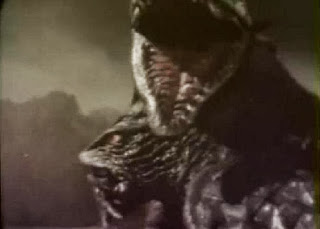... aka: Gamera Strikes Again
... aka: Gamera vs. Barugon
... aka: Godzilla, der Drache aus dem Dschungel
... aka: Great Monster Duel: Gamera vs. Barugon, The
... aka: War of the Monsters
Directed by:
Shigeo Tanaka
Gamera was Daiei's answer to rival studio
Toho's massively popular Godzilla. The series began with
Daikaijû Gamera
(or GAMERA, THE GIANT MONSTER) in 1965. A year later, the rights were
purchased up by Sandy Frank, who removed some of the original footage and
had new American scenes added for release under the title of Gammera
the Invincible. That same year in Japan, Daiei produced its first
Gamera sequel; Daikaijû kettô:
Gamera tai Barugon (1966).
The film was dubbed again for release on American TV by AIP as War of
the Monsters, and was re-issued theatrically later on (again by Frank) under
the title Gamera vs. Barugon. Unlike its predecessor, no new scenes were
added to it. Things open with a recap of the first film and Gamera's origins.
Resurrected by an atomic blast in the Arctic, Gamera was released from his
icy prison, where he'd been "almost since the beginning of time." After
laying waste to much of Japan, the giant, fire-loving turtle was lured
into a rocket, which was the sealed and shot to Mars. This film picks up
right there; only instead of actually reaching Mars, the rocket carrying
the creature is hit by a meteor and split open. Gamera is then hurtled
back to Earth for Round 2.
Gamera wastes no time causing death and destruction. He destroys a dam and
then goes to a volcano to feast on molten lava. Meanwhile in Osaka,
Keisuke Hirata (Kôjirô Hongô) decides to give up his job as a pilot
because he wants to own his own airline company, and he's found just the
way to make some quick cash. A few decades earlier during the war,
Keisuke's crippled army vet brother Ichiro (Akira Natsuki) had
stashed a giant opal worth at least 4 million dollars inside a cave in New
Guinea. Now he wants some able-bodied men to go get it. Keisuke, along
with two other men; Onodera (Kôji Fujiyama) and Kawajiri (Yûzô
Hayakawa), make the long boat trip to the island. Once they arrive,
they learn their destination is nicknamed "The Hill of Death" and that the
villagers forbid them from going. They venture into the jungle, anyway,
survive quicksand, snakes and bats and finally located the cave and the
opal. Kawajiri is bitten by a scorpion and quickly dies. Onodera decides
that he wants the opal all to himself, so he tosses a grenade at Keisuke
and runs off. The native villagers manage to save Keisuke, but by the time
they do Onodera is already on a boat headed toward Japan. Because removing
the opal from the cave will release a yet-to-be-determined curse, beautiful native girl Kara (Kyôko
Enami) must leave her island home for Japan to try to get it back.
As Onodera's ship docks in Kobe, Japan, the jewel is exposed to a powerful
heat lamp, which reveals it to not actually be an opal at all, but a
petrified egg. It hatches and a slimy little lizard-like creature crawls
out. An explosion occurs, the ships sinks and then from the depths of the
water comes a giant alligator-like horned monster called Barugon. It
crawls on all fours, stomps some buildings, shoots a rainbow that can blow
stuff up out of glowing spikes on its back and has a battering ram-like
tongue that shoots out snow which will freeze anything it touches. Tanks,
jets and missiles don't phase the beast. Drawn in by the heat, Gamera also
proves to be no match as Barugon, who freezes him after a scuttle. Kara
and Keisuke arrive from Japan, must deal with the evil, insanely greedy
Onodera (who has since murdered Keisuke's brother and his wife [Kazuko
Wakamatsu]) and then must save Japan from the rampaging lizard.
Barugon has a diamond fetish, so they first attempt to lure the beast into
a lake with a 6-thousand carat diamond. When that plan fails, they attempt
to use a giant mirror satellite dish to reflect Barugon's rainbow back
onto him. When that plan fails... well, there's always hope that Gamera
will thaw out in time for the finale.
Despite the general consensus, I actually found this far more enjoyable than
the original. It's a lot of fun, better paced and seems more geared toward an adult audience. The lost world-style
adventure scenes (albeit a bit brief) are a nice way to break from the usual
formula and there's plenty of smashing, explosions, monster action, highly
variable special effects and charming, clever and / or colorful little
touches throughout. It was followed by
Gamera vs. Gaos (1967; aka Return of the Giant Monsters),
Gamera vs. Viras (1968; aka Destroy All Planets), Gamera vs.
Guillon (1969; aka Attack of the Monsters), Gamera vs.
Monster X (1970) and Gamera vs. Zigra (1971) in the original
run. The series saw a
resurgence years later with the release of Gamera: The Guardian of the
Universe (1995), which also led to numerous sequels. This and many
others in the series are now in the public domain and easy to find.
★★★




















2 comments:
I would absolutely, positively avoid the PD version so of this like the plague. The film is beautifully composed for widescreen and color, neither of which can be at all appreciated in the murky faded PD transfers out there. Pick up the Shout! Factory disk and marvel at this Kaiju fairytale !!!
You're right... I really should check out the better version...
Post a Comment